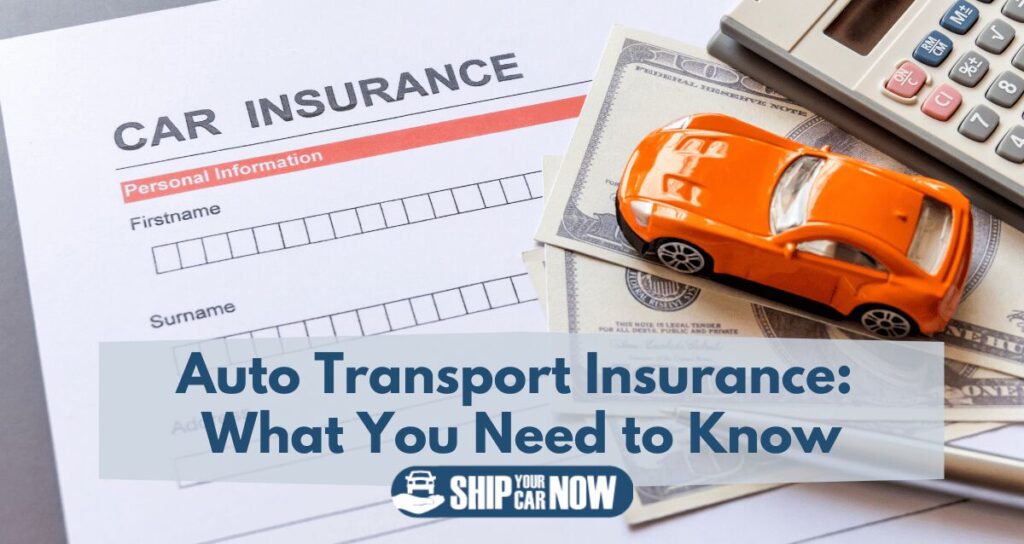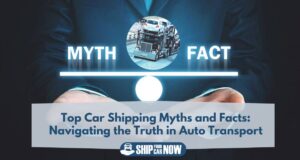
Key Takeaways
- Transport insurance is crucial for protecting your vehicle during shipment, providing coverage against potential damages, and ensuring compliance with legal requirements for auto transporters.
- Key risks in car shipping include damage from road hazards and weather conditions, with the choice between open and enclosed transport affecting the level of protection.
- Understanding the car shipping costs associated with transport insurance involves considering factors such as travel distance, vehicle value, and the type of coverage, emphasizing the importance of selecting the right insurance for peace of mind.
Understanding Transport Insurance
Auto transport insurance serves as a critical safeguard for your vehicle during its transit to another location. It is paramount that you grasp the intricacies of car shipping insurance whether you’re an aficionado moving a vintage automobile, part of a household embarking on a cross-country relocation, or an individual transferring for professional reasons.
By delving into this guide, you’ll gain insight into the essentials of shipping insurance—its functions, associated risks, and how it operates—and you will be provided with the necessary information to ensure informed decision-making for the protection and secure transport of your car.
Purpose of Auto Transport Insurance
During the shipping process, your vehicle is exposed to numerous risks. Auto transport insurance provides a shield of safety against these possible dangers by protecting your vehicle from harm while in transit. This type of insurance isn’t simply about offering protection—it’s also legally required for auto transport carriers to possess liability insurance that can cover damages incurred during their care.
Choosing an auto transporter goes beyond fulfilling basic legal requirements. It involves selecting a carrier whose commitment to meeting the necessary auto transport insurance standards reflects its dedication to maintaining the condition and security of your vehicle throughout its journey.
Key Risks in Car Shipping

Especially for high-value cars, the extra safeguarding offered by enclosed transport might be necessary to reduce damage risk during their journey. Nevertheless, it’s important to recognize that instances of vehicles being damaged while in transit are uncommon—occurring less than five percent of the time.
How Transport Insurance Works
Navigating the intricacies of insurance for vehicle transport can be as intricate as the mechanisms within the vehicles themselves. This process usually encompasses three distinct types of insurance policies: those held by you, your transporter, and occasionally a broker. Transporters offer primary coverage that acts as an initial shield against damages, while your own car’s policy might serve to provide supplementary backup protection. It’s vital to ascertain what is included in this provided coverage, including any restrictions or omissions, and also confirm if your personal automotive policy applies when transporting.
A thorough option for insurance may address various eventualities from theft to damage due to natural calamities. However, ‘Acts of God’ typically remain outside its purview. Be sure to acquire evidence verifying the transport company’s insurance policy and rigorously investigate it so you are reassured that during transit, all risks related to shipping are accounted for with respect to safeguarding your automobile comprehensively.
Types of Transport Insurance Coverage

It’s essential to explore from the fundamental coverage mandated by law through to more expansive policies that guard against unforeseen circumstances. Sifting through these options guarantees that your car insurance delivers adequate security for whatever journeys lie ahead.
Liability Insurance
Liability insurance is the foundation of protection during auto transport. It is a legal requirement and essential safeguard for every car shipping company to fulfill the law’s mandates. While owners are not required to secure additional insurance when transporting their vehicles, it is imperative that the chosen car transport firm delivers this coverage at no added cost.
Liability coverage affords a fundamental layer of defense by addressing any damage claims resulting from carrier negligence. This ensures that you are indemnified against costs associated with damages sustained while your automobile is under their stewardship during shipping.
Cargo Insurance
Insurance coverage is crucial for safeguarding your vehicle during transportation, with liability insurance offering fundamental protection. Cargo insurance provides more detailed coverage for any damages that might occur to your car while it’s being loaded onto a transport carrier, in transit, or being unloaded from the carrier. This encompasses unforeseen incidents such as theft and accidents. In the United States, most companies’ cargo insurance policies have an upper limit of approximately $350,000, covering all vehicles they are transporting at one time [1].
It is essential to confirm that the carrier you choose has adequate cargo insurance—specifically the carrier’s cargo insurance coverage—to ensure protection for your vehicle throughout its journey. Thoroughly reviewing the details of the carrier’s provided policy will help you understand the extent of protection against potential damage or loss offered by their insurance.
Additional Coverage Options

Brokers might not directly provide this form of insurance. They play an instrumental role in connecting you with an insurance company or third-party providers that offer these extra protections. They help make sure every aspect of your vehicle’s worth is safeguarded during transport.
Cost Factors in Transport Insurance
A few critical factors determine the cost associated with providing insurance coverage for your vehicle, including how far it will be transported, its current market value, and the specific type of insurance protection you opt for. It’s important not to cut corners on insurance just to reduce expenses. Instead, view choosing adequate coverage as an investment in your tranquility. Grasping these elements that influence the overall cost will help you strike a balance between economic considerations and ensuring your vehicle has sufficient coverage during transit.
Distance and Route
In the auto transportation industry, distance plays a crucial role beyond merely being a span between two locations. It’s an influential factor in determining your insurance premium for car shipping. As you transport your vehicle over longer distances, there is typically a reduction in the cost per mile, which implies that transporting your car over long distances can be more cost-effective on this basis. For example, when comparing the expenses of shipping a car across 500 miles to those of transporting it across 2,500 miles, one may notice significant savings due to the scale efficiencies within the auto transportation sector.
Regarding insurance costs during the transportation processes involved in moving cars, both the journey’s duration and complexity inherent to the route chosen will significantly impact the overall price. These elements are decisive factors that help shape what the total billable amount would look like in the end-of-day scenario.
Vehicle Value

When you’re gearing up to ship your vehicle, be mindful that its market value does more than boost ego—it plays an integral role in shaping the insurance equation.
Type of Coverage
Selecting the appropriate insurance coverage is crucial, much like choosing essential gear for a hassle-free road trip. Every type of insurance, whether it be liability or comprehensive and collision, provides unique benefits and has its own cost implications.
If you desire more peace of mind, gap coverage offers that additional layer of protection for damage costs between $1,000 to $5,000, but expect an increase in your premium by about $50 to $100. As with any substantial investment decision-making process, consider carefully the advantages and drawbacks associated with each type of coverage to ensure it fits both your requirements and financial plan.
Preparing Your Vehicle for Transport
Prior to shipping your car, proper preparation is crucial. By getting your vehicle ready for transport, you not only streamline the shipping process but also comply with the stipulations of your insurance coverage. Consider this as laying the groundwork for a successful journey: if your vehicle is adequately prepped, it stands a greater chance of reaching its destination unscathed, and in the event that any issues arise during transit, being well-prepared will improve your ability to handle the claims process with your insurance provider efficiently.
Removing Personal Items
Ensuring your vehicle is devoid of personal items goes beyond mere organization—it’s a crucial step in safeguarding your belongings. Personal articles are often not covered by transport insurance, making them susceptible to theft or harm while the car is being moved. By taking out these possessions before transit, you minimize potential losses and maintain the interior condition of your automobile as it was prior to shipment.
It’s also important to secure any remaining objects within the vehicle—like those stowed away in the trunk or cargo space—to prevent movement that could lead to damage during transportation.
Documenting Vehicle Condition

When coupled with the bill of lading that records any damage already present before shipping, this form of visual record-keeping creates a transparent path for insurance firms or transport companies to follow during any claims resolution process.
Inspection Before Signing Bill of Lading
The bill of lading serves as an official record confirming the state of your vehicle when it was first taken into custody by the carrier. Conducting a comprehensive review prior to endorsing this document is imperative, for it represents your final opportunity to register any inconsistencies, thereby safeguarding your ability to hold the shipping entity responsible for damages that may occur during transport.
Document every single instance of damage on the bill of lading, regardless of its extent. Feel free also to take additional photos specifically focusing on your car’s odometer to ensure the reported mileage is accurate. The diligence with which you scrutinize these details can prove crucial in facilitating a successful outcome in case there arises a need for you to initiate a claim process.
Choosing a Reputable Transport Company
Choosing the appropriate transport company is equally important as opting for the appropriate insurance coverage to safeguard your vehicle. The reputation, licensing, pricing transparency, and provided insurance of the company are significant factors that contribute to a secure and pleasing experience when shipping your vehicle. A trustworthy firm will honor your vehicle while offering essential support and confidence throughout the entire transportation process.
Verifying Insurance Information

Bear in mind that settling for insufficient insurance can pose a major risk when shipping your car. Meticulously scrutinize every aspect of the terms and conditions before sealing any deal with a shipping service.
Evaluating Company Reputation
The standing of a transport company can reflect the kind of experience you may encounter with them. Explore reviews and ratings on reputable sites to gauge the firm’s dependability. It is beneficial to request references and engage in conversations with previous customers for direct insights into their service quality.
How long a company has been in operation, and its connections within the transportation sector often signal dedication to excellence and dependable service. Invest effort into investigating these factors because they usually mirror how well your vehicle will be cared for during its journey.
Comparing Quotes and Services
The expense involved in selecting a transport company certainly plays a role. It should not be the only criteria guiding your decision. To make an informed choice:
- Gather several estimates
- Examine these estimates thoroughly, looking beyond the total cost to understand the level of service being offered
- Guard against seemingly exceptionally low offers that could potentially conceal substandard service or hidden charges [3].
It’s important also to take into account the level of customer service and support provided by the company, as this aspect is often as pivotal as the price in guaranteeing a seamless transportation experience.
Filing a Claim for Transport Damage
In the event that damage occurs during the shipping of a vehicle, it is crucial to understand how to proceed with filing a claim. Prompt action and thorough documentation can greatly streamline the process and enhance your chances for an agreeable outcome.
If efforts to resolve matters with the auto shipping company prove unsatisfactory, there are avenues available such as submitting complaints to organizations like the US Department of Transportation or the Better Business Bureau.
Initial Inspection and Documentation

Subsequently, conduct another examination with care to reveal any hidden impairments that may have been overlooked initially. Accumulate all necessary paperwork, such as photos marked with the date and time, which will bolster your claim if needed.
Contacting the Transport Company
Should you notice any damage, please take the following actions:
- Immediately reach out to the transport company’s customer service department.
- Furnish them with comprehensive documentation of the damage. This should include photos to speed up the claims procedure.
- Prompt action is crucial. Ensure that you inform the carrier within a five-day period to facilitate a swift response and initiate resolution measures for your situation.
Submitting a Claim Form
It is crucial to proceed with the submission of a claim form in response to damage incurred during transport. This document must thoroughly detail the shipment information, affirming the carrier’s liability and clearly stating the financial compensation being sought. To adhere to regulations like those outlined in the Carmack Amendment, it’s imperative that this claim be filed within a prescribed period—often 14 days.
ShipYourCarNow: Premium Vehicle Transport with Unmatched Security and Customer Support

Should unforeseen circumstances arise, rest assured that our dedicated claim support is ready to assist you through every phase. Our commitment lies in keeping customer satisfaction at the forefront while safeguarding your vehicle throughout its journey.
Full Summary
Securing insurance for vehicle transport is essential for the secure delivery of your car. This coverage provides defense against numerous risks to ensure that your vehicle reaches its destination safely. It’s important to carefully select suitable coverage, adequately prepare your car for shipment, and choose a trustworthy car shipping company—all vital steps in protecting your automotive investment. In the event of any problems during transit, understanding how to submit an insurance claim is critical for prompt and equitable resolution. Despite seeming like one more task on your list to check off, the importance of transport insurance in safeguarding the safety and security of our vehicles should not be underestimated.
Frequently Asked Questions
Is auto transport insurance required by law for all carriers?
Yes, all auto transport companies are legally required to carry liability insurance, which provides basic protection for your vehicle during transit.
What should I do if I notice damage to my vehicle after it’s been shipped?
Should you detect any damage to your vehicle following its shipping, ensure you capture the damage comprehensively with photographs. Next, scrutinize this evidence alongside the bill of lading and initiate communication with the shipping company to notify them about the problem and commence with the claims procedure.
Can I ship personal items in my vehicle during transport?
If you’re asking yourself if you can ship personal items in your vehicle, it is advised for you to clear out any personal items since they fall outside the protection of the carrier’s cargo insurance before shipping your car.
To ensure the safety and security of your belongings, it is advisable to keep them with you.
How does the value of my vehicle affect transport insurance costs?
Insurance costs for your transport are directly influenced by the value of your vehicle. As the value of a vehicle rises, so may the associated insurance charges, owing to the heightened likelihood of incurring more substantial repair or replacement expenses.
What is GAP insurance, and should I consider it for transporting my vehicle?
Certainly, it is advisable to get GAP insurance for your vehicle during transport, particularly if the vehicle is newer and holds a significant value. This type of insurance is designed to cover the shortfall between the actual value of your car and any outstanding loan balance in the unfortunate event that your vehicle experiences a total loss while being transported.
Senior automotive logistics professional with a passion for the industry and a 10+ year history of accomplishments. Proven track record of exemplary client management working with both RMCs, Van Lines and OEMs. Keen ability to react to an ever-changing marketplace while offering superior technology solutions, programs and services. Architect of award winning auto transport portal technology offering transparency and agility to clients, agents and transferees. Successful team builder and leader easily managing budgets with effective leadership, strategic planning, and problem-solving capabilities.















